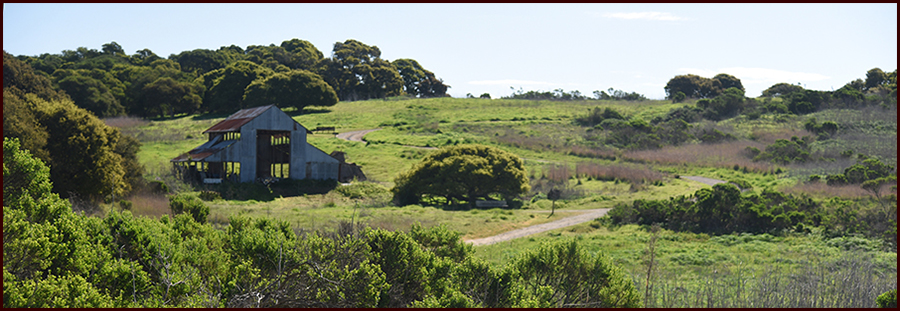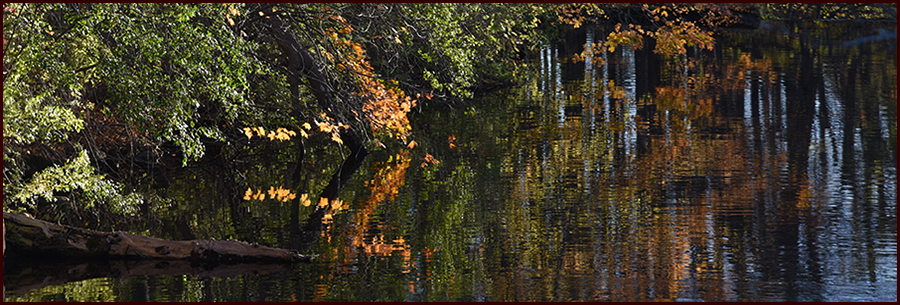Down Where the River Meets the Road Words & Music by Steve Gillette & Barry Hyman
The cool of the forest on a hot summer day, and the old abandoned road leading down off the bluff to the river. That sweet hidden place where we could escape from the world and delight in the sensual joys of young love. Before I get into trouble with this, I'd better try to show how all this is relevant to songwriters. But of course, that's pretty self evident.
A nostalgic vision of a simpler past and the remembrance of how good it felt to be young and to splash in the cool water and lay in the dappled light of the shady bank. There I go again. But I think that's half the point, the listener will follow you into those enchanted places of memory and fantasy, and why not? What's so real about reality that it can displace the sweet enduring illusion of young love?
It's not a bad idea commercially speaking either. Lots of great precedent there. I've been haunted pleasantly for years with a couple of lines from an old song, “Sometimes I think about little Willie Jean. Did she ever get as far as New Orleans?”
It's a song that made the rounds of the coffeehouses of California during the sixties. It was credited to Blind Willie McTell, the legendary Piedmont blues man who first recorded for Alan Lomax. I heard versions of the song by Hoyt Axton and Mose Allison and others. As I remember it, there is a verse about the man being incarcerated on the county farm, and so the sense of loss is enhanced.
There is nothing quite so dire in our song; just a try at framing a moment in our imaginations that calls us back to a simpler time. Still, I thought from the beginning that the idea had merit and I guess I imposed it on Barry. He was quite in agreement about the Southern Blues musical genre and was able to provide a lot of credibility in that department with slide guitar and pedal steel.
Barry comes from a creative family. He grew up just around the corner from where we live. His mom was Shirley Jackson who wrote many famous unsettling stories like "The Lottery" and "The Haunting of Hill House" and all his siblings are artists of one sort or another. He's always been in three or four bands at a time and is currently finding creative ways to jam with social distancing.
From the beginning, I had the image of that sacred place along the bank with the dappled light and the lapping of the river, but somehow couldn't get past the big concrete overpass where the road went across the river. That just didn't seem to fit. It wasn't until I stumbled onto the old, long abandoned, rutted and overgrown logging road that things fell into place.
Merriam Webster describes a trace as a path, trail, or road made by the passage of animals, people, or vehicles. Also a sign or evidence of some past thing; a vestige. And that says everything. So armed with the image and some language we set about to create a memorable visit to our youth. Or somebody's youth.
One night on stage I was singing “Grapes On the Vine,” the song that Charles John Quarto and I wrote early in our collaboration. I moved a finger in an unexpected way, not really a mistake, and not really a conscious exploration, but one of those dreamlike actions that are partly automatic pilot and partly bringing the song to life in a new way. These experiments are usually not helpful.
But in this case, I was raising the root note of the A chord, the V chord in the song by one half step, as I moved my index finger to press the first fret of the fifth string, the open A string. This served to create a passing tone, A# leading by another half-step to the next chord, the B minor or vi minor. Try this a couple of times and it will seem simple. I just hadn't stumbled onto it before that night.
That same passing note comes into play in this song. It occurs in the second line of the verse which starts on E minor, the ii minor chord, then moves to A, the V or dominant chord of the song. But then the bass root note of the A is elevated to A# to lead again to the B of the B minor chord. This motion by half step can be compelling whether moving up or down, and I encourage you to experiment with it.
For the bridge I take the melody up to the four chord, the G or sub-dominant, and readers of these articles will recognize that as something that I often do. I hold this chord for two measures to establish a new musical theme and give a chance for some harmony, returning to the D and then coming to rest momentarily on the A, the five chord or the dominant of the key.
Now one might expect that the song would employ that passing tone as we had in the verse, but instead of using it there, we wait for the walk down in the next line of the bridge. Starting on the G and going to the B minor then passing through that A with the A# in the bass before settling into the A chord with a sense of resolving to the dominant before starting out again with the verse in D.
The chart will help you to follow along. The A# is a dissonance, a juicy element with what I think is a very good effect. Again too much of a good thing can be bad, so it's good to have a scheme that allows you to get the benefit of the unexpected without becoming predictable or even trite.
There is a gratuitous phrase at the end of the bridge which has troubled me. It's after the line 'funny how a man may search the world over, only to find his way home.' The line is 'and to know it for the first time.' It's a paraphrase of T. S. Eliot from his famous poem Little Gidding:
“We shall not cease from exploration
And the end of all our exploring
Will be to arrive where we started
And know the place for the first time.”
It's a wonderful idea, I've always thought it was very meaningful, prodigal son and all that, but I could not find a way to get the three phrases to fall into a metrical pattern that worked. Someone might still achieve that but for now it's just there, sticking out like an assertive thumb. It brings the song to a bit of a halt, but maybe that's OK.
I think it's very relevant to what we were trying to express in our song — mainly that with the passing of time certain things become clearer even if only half remembered. And so the last verse takes up the idea that somewhere it might be possible to retrieve all that lost opportunity, if only in reverie.
Anyway, I love this song. My hope is that someone will discover it and make it memorable. That hope is pretty consistent with the process of writing as I know it. Gone are the days when I was seeking to be 'the one,' the privileged artist who could carry the banner for a major corporate assault on the pop charts.
That sort of thing takes millions of somebody's money. Instead a person can write a pretty good song, make a decent demo on his workstation at home, send it along in an email for less than the price of a postcard, and dine on platinum. That is I could dine on one of those platinum discs except that they put that damned hole in the middle. (I have a feeling it's not really platinum!)
Cindy Mangsen and I made our annual pilgrimage across the Hudson to sing at Caffe Lena in January and they gave us a video of the occasion. Here's the portion with “Down Where the River Meets the Road” with a little embarrassing banter at the beginning. Before the concert we had done an interview with Vivian Nesbitt for her public radio series, the Art of the Song. That's what I was babbling about.
Steve & Cindy Perform "Down Where the River Meets the Road."
Video courtesy Caffè Lena
This video uses the track that Barry and I recorded of our song. This is the one we offer as a demo to the recording industry, and I think it works pretty well. We hope you enjoy it.
Steve Gillette & Barry Hyman's recording of "Down Where the River Meets the Road."
Video by Steve
My recording of "Down Where the River Meets the Road" is available for purchase as a digital download here, as an MP3 file or a lossless FLAC file.
So here you have it.
For those who might want to sing the song here are the lyrics and chords:
To
When the
And
There’s a
And to
And if your
And if
To
© 2017, Compass Rose Music, BMI


